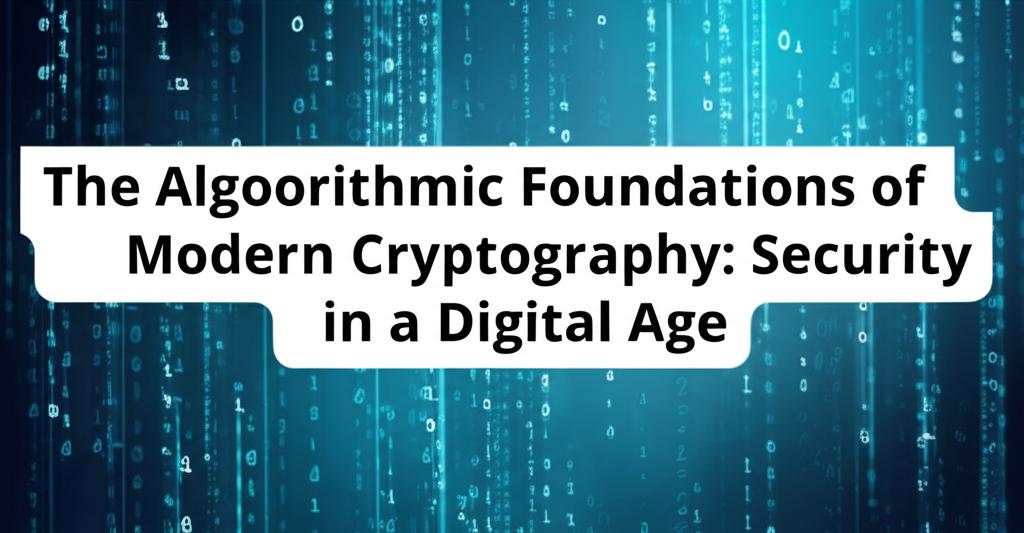In today's interconnected world, the security of digital information is paramount. Cryptography, the science of secure communication, provides the essential tools to protect data confidentiality, integrity, and authenticity. This article explores the core algorithmic principles that underpin modern cryptographic systems and how they secure our digital lives.
At its heart, cryptography involves transforming readable information (plaintext) into an unreadable format (ciphertext) using mathematical algorithms and a key. Only those with the correct key can reverse the process (decrypt) and access the original information. Modern cryptographic techniques are broadly categorized into two main types: symmetric and asymmetric encryption.
Symmetric Encryption: The Single Key SystemSymmetric encryption algorithms, such as the widely adopted Advanced Encryption Standard (AES), use a single secret key for both encrypting plaintext and decrypting ciphertext. This shared key must be known by both the sender and the receiver of the information.
- How it Works: The algorithm performs a series of complex substitutions and permutations on the data, determined by the key. The strength of symmetric encryption often lies in the length of the key; longer keys generally offer greater security (e.g., AES supports 128, 192, and 256-bit keys).
- Advantages: Symmetric algorithms are generally faster and more computationally efficient, making them well-suited for encrypting large volumes of data.
- Challenges: The primary challenge is secure key exchange. If the key is intercepted during distribution, the security of the encrypted data is compromised.
Also known as public-key cryptography, asymmetric encryption utilizes a pair of mathematically related keys: a public key and a private key.
- How it Works: The public key can be freely shared and is used to encrypt data. However, only the corresponding private key, which is kept secret by the owner, can decrypt that data. Prominent examples of asymmetric algorithms include RSA (Rivest-Shamir-Adleman) and Elliptic Curve Cryptography (ECC).
- Advantages: Asymmetric encryption resolves the key distribution problem inherent in symmetric systems. It is also fundamental for creating digital signatures, which verify the authenticity and integrity of a message.
- Applications: Secure email, online financial transactions, and secure web communication (SSL/TLS protocols) heavily rely on asymmetric cryptography. While generally slower than symmetric encryption, it's often used to securely exchange a symmetric key, which is then used for bulk data encryption.
Hash functions are another critical component of modern cryptography. These algorithms take an input (or "message") and return a fixed-size string of bytes, typically a "digest" or "hash."
- Key Properties:
Deterministic: The same input will always produce the same hash.
Pre-image Resistance: It's computationally infeasible to determine the original input from its hash.
Second Pre-image Resistance: Given an input and its hash, it's computationally infeasible to find a different input that produces the same hash.
Collision Resistance: It's computationally infeasible to find two different inputs that produce the same hash.
- Applications: Hash functions are used to verify data integrity (ensuring data hasn't been altered), store passwords securely (by storing hashes of passwords instead of the passwords themselves), and in digital signatures. Common examples include SHA-256 (Secure Hash Algorithm 256-bit).
The field of cryptography is far from static. It continually evolves to address new threats and technological advancements.
- Emerging Threats: Cyber attackers are constantly developing more sophisticated techniques, pushing the boundaries of existing cryptographic methods.
- Quantum Computing: The advent of practical quantum computers poses a significant future threat to many current public-key algorithms (like RSA and ECC), as quantum computers could potentially solve the underlying mathematical problems much faster than classical computers. This has spurred research into post-quantum cryptography (PQC) – the development of cryptographic algorithms that are secure against attacks from both classical and quantum computers. Standardization bodies like NIST (National Institute of Standards and Technology) are actively evaluating and standardizing PQC algorithms.
- "Harvest Now, Decrypt Later": A concerning strategy involves malicious actors collecting encrypted data today with the intent of decrypting it in the future when more powerful computing (like quantum computers) becomes available. This underscores the urgency of transitioning to quantum-resistant cryptography.
- Advanced Cryptography Techniques: Researchers are exploring novel cryptographic methods like Fully Homomorphic Encryption (FHE), which allows computations to be performed on encrypted data without decrypting it first, and Multi-Party Computation (MPC), enabling multiple parties to jointly compute a function over their inputs while keeping those inputs private.
- Artificial Intelligence (AI) and Machine Learning (ML): AI and ML are becoming increasingly integrated into cybersecurity. AI can assist in detecting anomalies in network traffic or user behavior that might indicate an attack, reverse-engineer malware, and even help identify vulnerabilities in code. AI can also automate security processes, enabling faster threat detection and response.
Given the dynamic nature of threats and cryptographic advancements, organizations need to cultivate "crypto agility." This refers to the ability to quickly adapt and transition to new cryptographic algorithms, protocols, and standards as needed. Automated certificate lifecycle management and flexible system architectures are key to achieving this.
In conclusion, the algorithmic foundations of modern cryptography are essential for securing our digital interactions, from personal communications to global commerce. As technology and threats continue to evolve, so too will the cryptographic methods designed to protect our information, ensuring that security remains robust in an increasingly digital age. The ongoing development of quantum-resistant algorithms and advanced cryptographic techniques highlights the continuous innovation required to maintain digital trust and privacy.

